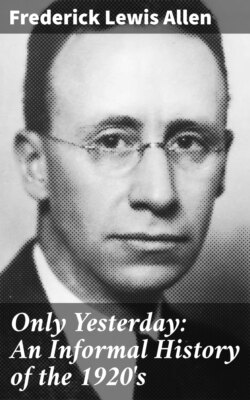Читать книгу Only Yesterday: An Informal History of the 1920's - Frederick Lewis Allen - Страница 14
На сайте Литреса книга снята с продажи.
[2]
ОглавлениеTable of Contents
The events of 1919 did much to feed this fear. On the 28th of April--while Wilson was negotiating the Peace Treaty at Paris, and homecoming troops were parading under Victory Arches--an infernal machine "big enough to blow out the entire side of the County-City Building" was found in Mayor Ole Hanson's mail at Seattle. Mayor Hanson had been stumping the country to arouse it to the Red Menace. The following afternoon a colored servant opened a package addressed to Senator Thomas R. Hardwick at his home in Atlanta, Georgia, and a bomb in the package blew off her hands. Senator Hardwick, as chairman of the Immigration Committee of the Senate, had proposed restricting immigration as a means of keeping out Bolshevism.
At two o'clock the next morning Charles Caplan, a clerk in the parcel post division of the New York Post Office, was on his way home to Harlem when he read in a newspaper about the Hardwick bomb. The package was described in this news story as being about six inches long and three inches wide; as being done up in brown paper and, like the Hanson bomb, marked with the (false, of course) return address of Gimbel Brothers in New York. There was something familiar to Mr. Caplan about this description. He thought he remembered having seen some packages like that. He racked his brain, and suddenly it all came back to him. He hurried back to the Post Office--and found, neatly laid away on a shelf where he had put them because of insufficient postage, sixteen little brown-paper packages with the Gimbel return address on them. They were addressed to Attorney-General Palmer, Postmaster-General Burleson, Judge Landis of Chicago, Justice Holmes of the Supreme Court, Secretary of Labor Wilson, Commissioner of Immigration Caminetti, J. P. Morgan, John D. Rockefeller, and a number of other government officials and capitalists. The packages were examined by the police in a neighboring firehouse, and found to contain bombs. Others had started on their way through the mails; the total number ultimately accounted for reached thirty-six. (None of the other packages were carelessly opened, it is hardly necessary to say; for the next few days people in high station were very circumspect about undoing brown-paper packages.) The list of intended recipients was strong evidence that the bombs had been sent by an alien radical.
Hardly more than a month later there was a series of bomb explosions, the most successful of which damaged the front of Attorney-General Palmer's house in Washington. It came in the evening; Mr. Palmer had just left the library on the ground floor and turned out the lights and gone up to bed when there was a bang as of something hitting the front door, followed by the crash of the explosion. The limbs of a man blown to pieces were found outside, and close by, according to the newspaper reports, lay a copy of Plain Words, a radical publication.
The American public read the big headlines about these outrages and savagely resolved to get back at "these radicals."
How some of them did so may be illustrated by two incidents out of dozens which took place during those days. Both of them occurred on May Day of 1919--just after Mr. Caplan had found the brown-paper packages on the Post Office shelf. On the afternoon of May Day the owners and staff of the New York Call, a Socialist paper, were holding a reception to celebrate the opening of their new office. There were hundreds of men, women, and children gathered in the building for innocent palaver. A mob of soldiers and sailors stormed in and demanded that the "Bolshevist" posters be torn down. When the demand was refused, they destroyed the literature on the tables, smashed up the offices, drove the crowd out into the street, and clubbed them so vigorously--standing in a semicircle outside the front door and belaboring them as they emerged--that seven members of the Call staff went to the hospital.
In Cleveland, on the same day, there was a Socialist parade headed by a red flag. An army lieutenant demanded that the flag be lowered, and thereupon with a group of soldiers leaped into the ranks of the procession and precipitated a free-for-all fight. The police came and charged into the mêlée--and from that moment a series of riots began which spread through the city. Scores of people were injured, one man was killed, and the Socialist headquarters were utterly demolished by a gang that defended American institutions by throwing typewriters and office furniture out into the street.
The summer of 1919 passed. The Senate debated the Peace Treaty. The House passed the Volstead Act. The Suffrage Amendment passed Congress and went to the States. The R-34 made the first transatlantic dirigible flight from England to Mineola, Long Island, and returned safely. People laughed over The Young Visiters and wondered whether Daisy Ashford was really James M. Barrie. The newspapers denounced sugar-hoarders and food profiteers as the cost of living kept on climbing. The first funeral by airplane was held. Ministers lamented the increasing laxity of morals among the young. But still the fear and hatred of Bolshevism gripped the American mind as new strikes broke out and labor became more aggressive and revolution spread like a scourge through Europe. And then, in September, came the Boston police strike, and the fear was redoubled.
